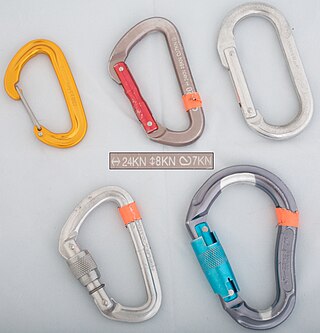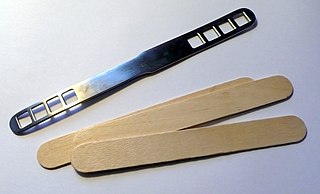
The American National Standards Institute is a private nonprofit organization that oversees the development of voluntary consensus standards for products, services, processes, systems, and personnel in the United States. The organization also coordinates U.S. standards with international standards so that American products can be used worldwide.

British Standards (BS) are the standards produced by the BSI Group which is incorporated under a royal charter and which is formally designated as the national standards body (NSB) for the UK. The BSI Group produces British Standards under the authority of the charter, which lays down as one of the BSI's objectives to:
Set up standards of quality for goods and services, and prepare and promote the general adoption of British Standards and schedules in connection therewith and from time to time to revise, alter and amend such standards and schedules as experience and circumstances require.

A carabiner or karabiner, often shortened to biner or to crab, colloquially known as a (climbing) clip, is a specialized type of shackle, a metal loop with a spring-loaded gate used to quickly and reversibly connect components, most notably in safety-critical systems. The word comes from the German Karabiner, short for Karabinerhaken, meaning "carbine rifle hook" used by a carbine rifleman, or carabinier, to attach his carbine to a belt or bandolier.

A safe is a secure lockable enclosure used for securing valuable objects against theft or fire. A safe is usually a hollow cuboid or cylinder, with one face being removable or hinged to form a door. The body and door may be cast from metal or formed out of plastic through blow molding. Bank teller safes typically are secured to the counter, have a slit opening for dropping valuables into the safe without opening it, and a time-delay combination lock to foil thieves. One significant distinction between types of safes is whether the safe is secured to a wall or structure or if it can be moved around.
BACnet is a communication protocol for building automation and control (BAC) networks that use the ASHRAE, ANSI, and ISO 16484-5 standards protocol.

ASTM International, formerly known as American Society for Testing and Materials, is an international standards organization that develops and publishes voluntary consensus technical standards for a wide range of materials, products, systems, and services. Some 12,575 ASTM voluntary consensus standards operate globally. The organization's headquarters is in West Conshohocken, Pennsylvania, about 5 mi (8.0 km) northwest of Philadelphia.

A medical device is any device intended to be used for medical purposes. Significant potential for hazards are inherent when using a device for medical purposes and thus medical devices must be proved safe and effective with reasonable assurance before regulating governments allow marketing of the device in their country. As a general rule, as the associated risk of the device increases the amount of testing required to establish safety and efficacy also increases. Further, as associated risk increases the potential benefit to the patient must also increase.

Padlocks are portable locks usually with a shackle that may be passed through an opening to prevent use, theft, vandalism or harm.

An equestrian helmet is a form of protective headgear worn when riding horses. This type of helmet is specially designed to protect the rider's head in the event of falls from a horse, especially from striking a hard object while falling or being accidentally struck in the head by a horse's hoof.

A luggage lock is a lock used to prevent luggage from opening by accident, usually with little or no security in mind, although the lock may serve as a deterrent to potential thieves. Luggage locks may be built into luggage or may be external locks such as padlocks or lockable straps.
CODEN – according to ASTM standard E250 – is a six-character, alphanumeric bibliographic code that provides concise, unique and unambiguous identification of the titles of periodicals and non-serial publications from all subject areas.

A universal testing machine (UTM), also known as a universal tester, materials testing machine or materials test frame, is used to test the tensile strength and compressive strength of materials. An earlier name for a tensile testing machine is a tensometer. The "universal" part of the name reflects that it can perform many standard tensile and compression tests on materials, components, and structures.
A test method is a method for a test in science or engineering, such as a physical test, chemical test, or statistical test. It is a definitive procedure that produces a test result. In order to ensure accurate and relevant test results, a test method should be "explicit, unambiguous, and experimentally feasible.", as well as effective and reproducible.
A specification often refers to a set of documented requirements to be satisfied by a material, design, product, or service. A specification is often a type of technical standard.
A technical standard is an established norm or requirement for a repeatable technical task which is applied to a common and repeated use of rules, conditions, guidelines or characteristics for products or related processes and production methods, and related management systems practices. A technical standard includes definition of terms; classification of components; delineation of procedures; specification of dimensions, materials, performance, designs, or operations; measurement of quality and quantity in describing materials, processes, products, systems, services, or practices; test methods and sampling procedures; or descriptions of fit and measurements of size or strength.

Package testing or packaging testing involves the measurement of a characteristic or property involved with packaging. This includes packaging materials, packaging components, primary packages, shipping containers, and unit loads, as well as the associated processes.
Floor slip resistance testing is the science of measuring the coefficient of friction of flooring surfaces, either in a laboratory or on floors in situ. Slip resistance testing is usually desired by the building's owner or manager when there has been a report of a slip and fall accident, when there has been a report of a near accident, or (preferably) before the flooring is installed on the property. Flooring is tested using a tribometer to discover if there is a high propensity for slip and fall accidents on it, either dry and/or when wet with water or lubricated with other contaminants such as kitchen grease, hydraulic oil, etc. There have been numerous floor slip resistance testing tribometers and lab devices produced around the world to measure both the static (stationary) and dynamic coefficient of friction, but presently there are only a few that have been proven to be reliable for obtaining useful safety results and that have current official test methods. Static coefficient of friction (SCOF) testing has always been unreliable for assessing safety in the wet condition, so any reliable slip resistance test will be measuring the available slip resistance to someone who is moving (dynamic) across the floor, and therefore will be assessing dynamic coefficient of friction (DCOF). If an instrument has no official published test method, or has a withdrawn test method, then there is a problem with the instrument, often being poor precision.
ASTM International's Committee on Cannabis (D37) began developing technical standards for cannabis stakeholders in 2017. The committee was formed after a January conference hosted by American Public Health Association, an organizational meeting on Feb. 28 at ASTM International's global headquarters in West Conshohocken, Pennsylvania, and approval by the organization's board of directors on April 25. Americans for Safe Access (ASA) and many other organizations are partnering with ASTM International to develop seed-to-consumer quality standards that ASA say they hope become mandatory. D37 includes several subcommittees: indoor and outdoor horticulture and agriculture; quality management systems; laboratory; processing and handling; security and transportation; and personnel training, assessment, and credentialing.